Enhancing Sustainability through Accessible Health Platforms: A Scoping Review
Abstract
:1. Introduction
2. Literature Review: Web Accessibility and Sustainability
3. Methods
3.1. Study Approach and Research Questions
3.2. Search Strategy and Quality Evaluation
3.3. Screening of Studies
3.4. Data Extraction Review and Quality Outcomes
4. Results
4.1. Bibliometric Analysis
4.1.1. RQ1: Which Journals Publish Papers on the Web Accessibility of Healthcare?
4.1.2. RQ2: What Is the Journal Ranking for the Included Papers?
4.1.3. RQ3: What Is the Frequency of Publication of Web Accessibility Studies in Healthcare over Time?
4.2. Scoping Review
4.2.1. RQ4: What Are the Standards and Disability Guidelines Used in the Included Papers?
4.2.2. RQ5: What Empirical Methods Are Used to Evaluate the Accessibility of Health-Related Platforms?
4.2.3. RQ6: What Type of Online Tools or Services, Real Users, and Experts Have Helped to Evaluate Website Accessibility?
- (1)
- Achecker: The accessibility checker is a digital tool for website evaluation based on the WCAG; it is used to rapidly scan the website of interest to identify the technical accessibility errors and issues it presents [31].
- (2)
- WAVE: this comprises a set of evaluation instruments designed to enhance the accessibility of web content for individuals with disabilities; it not only identifies numerous accessibility and WCAG errors, but it is also centered on addressing issues known to affect end users, promoting human assessment, and educating about web accessibility [16].
- (3)
- TAW: The web accessibility test (Test de Accesibilidad Web in Spanish) developed to verify the level of compliance with accessibility requirements of web pages against the WCAG 1.0, 2.0, and 2.1 [15]; the final report includes a list of problems, warnings, and non-reviewed items [62]. The Spanish Foundation Centre created it to develop Information and Communication Technologies in Asturias (CTIC) [63]. The sustainable approach implies that this combination of assessment methods is a constant practice and that the tools and services are up-to-date and adaptable. The analysis also highlights the most common automatic assessment tools in the included articles. To ensure sustainability in this context, these tools must remain effective as web technologies and accessibility guidelines evolve.
4.2.4. RQ7: What Are the Disabilities Analyzed in the Accessibility Evaluations of Healthcare Platforms?
4.2.5. RQ8: What Are the WCAG and Conformance Levels That Have Been Used in the Evaluation of Healthcare Platforms?
4.2.6. RQ9: Does the Document Describe the Errors or Faults Detected When Evaluating the Accessibility of a Website?
4.2.7. RQ10. What Are the Results Obtained from Evaluating the Accessibility of Health-Related Platforms?
5. Discussion
6. Conclusions, Limitations, and Future Work
Author Contributions
Funding
Institutional Review Board Statement
Informed Consent Statement
Data Availability Statement
Acknowledgments
Conflicts of Interest
Appendix A
| RQ1 | RQ2 | RQ3 | ||||
|---|---|---|---|---|---|---|
| Paper ID | Type | Journal Name | Subject Area | Country | SJR | Pub, Year |
| JiA22 | Journal | International Journal of Environmental Research and Public Health | Environmental Science | Switzerland | Q2 | 2022 |
| TeN22 | Journal | SN Computer Science | Computer Science | Germany | Q2 | 2022 |
| NaA22 | Journal | Universal Access in the Information Society | Computer Science | Germany | Q2 | 2022 |
| NaB22 | Conference | ACM SIGMM International Workshop | Computer Science | United States | N/A | 2022 |
| AnB22 | Conference | CEUR Workshop Proceedings | Computer Science | United States | N/A | 2022 |
| SeM22 | Journal | Universal Access in the Information Society | Computer Science | Germany | Q2 | 2022 |
| KuS22a | Conference | Smart Innovation, Systems and Technologies | Computer Science | Germany | Q4 | 2022 |
| KuS22b | Conference | Lecture Notes in Networks and Systems | Computer Science, Engineering | Switzerland | Q4 | 2022 |
| GlA21 | Conference | Lecture Notes in Networks and Systems | Computer Science, Engineering | Switzerland | Q4 | 2021 |
| PaA21 | Conference | Lecture Notes in Networks and Systems | Computer Science, Engineering | Switzerland | Q4 | 2021 |
| ElF20 | Journal | International Journal of Environmental Research and Public Health | Environmental Science, Medicine | Switzerland | Q2 | 2020 |
| MuA20 | Journal | Studies in health technology and informatics | Engineering, Medicine | Netherlands | Q3 | 2020 |
| YoJ20 | Journal | Universal Access in the Information Society | Computer Science | Germany | Q2 | 2020 |
| PaA20a | Conference | Advances in Intelligent Systems and Computing | Computer Science, Engineering | Germany | Q4 | 2020 |
| PaA20b | Conference | Communications in Computer and Information Science | Computer Science, Mathematics | Germany | Q4 | 2020 |
| PaA20c | Conference | Advances in Intelligent Systems and Computing | Computer Science, Engineering | Germany | Q4 | 2020 |
| PaA20d | Conference | Advances in Intelligent Systems and Computing | Computer Science, Engineering | Germany | Q4 | 2020 |
| CeS19 | Journal | Arabian Journal for Science and Engineering | Multidisciplinary | Germany | Q1 | 2019 |
| LuC19 | Journal | Gaceta Sanitaria | Medicine | Spain | Q3 | 2019 |
| PaA18a | Conference | IEEE Ecuador Technical Chapters Meeting (ETCM) | Computer Science, Engineering, | United States | N/A | 2018 |
| PaA18b | Conference | International Conference on eDemocracy & eGovernment (ICEDEG) | Computer Science, Social Sciences | United States | N/A | 2018 |
| JoM17 | Journal | Computers in Human Behavior | Computer Science | United Kingdom | Q1 | 2017 |
| ArK17 | Conference | Confluence The Next Generation Information Technology Summit | Computer Science | United States | N/A | 2017 |
| EdL15 | Conference | Association of Information Systems (AIS) | Computer Science | United States | N/A | 2015 |
| LaO05 | Journal | Informatics for Health and Social Care | Health Professions, Medicine, Nursing, | United Kingdom | Q1 | 2005 |
| GrB22 | Journal | Disability and Health Journal | Medicine | United States | Q1 | 2022 |
| SaA21 | Journal | Journal of the American Medical Informatics Association | Medicine | United States | Q1 | 2021 |
| NoY18 | Journal | Business and Professional Communication Quarterly | Arts and Humanities, Business, Management, Economics | United States | Q2 | 2018 |
| NoY21 | Journal | Universal Access in the Information Society | Computer Science | Germany | Q2 | 2021 |
| RQ4 | RQ5 | RQ6 | RQ7 | |||
|---|---|---|---|---|---|---|
| Paper ID | Standards | Method Used | Automatic Tools | Real Users | Manual Tools | Disabilities |
| JiA22 | WCAG 2.0/2.1 | Automatic and manual evaluation | Mauve++, Nibbler, WAVE, AChecker, SortSite | YES | Expert’s review | Visual disability, auditory disability, physical disability, speech problem, cognitive/neurological problem, other disabilities (non-specified) |
| TeN22 | WCAG 2.0/2.1 | Automatic evaluation | Access Monitor, Achecker 2.1 | NO | N/A | Not specified (disabled users in general) |
| NaA22 | WCAG 2.0/2.1 Section 508 | Automatic evaluation | AChecker, WAVE, W3C HTML Validator, W3C CSS Validator | NO | N/A | Not specified (disabled users in general) |
| NaB22 | WCAG 2.0/2.1. ISO 9241-171:2008 [60] | Manual evaluation | Evaluation of Learning Management Systems (LMS): Moodle, Eliademy, Docebo, Sakai, Atutor | YES | Expert’s review | Elderly users, children, people with chronic diseases, disabled people (visual, auditory, and motor impairments) |
| AnB22 | WCAG 2.0/2.1 | Manual evaluation | N/A | YES | Expert’s review (from centers of reference, healthcare services, mobile units) | Poor people, disabled people, people with chronic conditions, older people, and children |
| SeM22 | WCAG 2.0 | Automatic evaluation | TAW, Deadlink Checker, Google Mobile-Friendly Test | NO | N/A | Not specified (disabled users in general) |
| KuS22a | WCAG 2.0 | Automatic evaluation | TAW, GTMetrix | NO | N/A | Not specified (disabled users in general) |
| KuS22b | WCAG 2.0 | Automatic evaluation | AChecker, WAVE, TAW | NO | N/A | Not specified (disabled users in general) |
| GlA21 | WCAG 2.1 | Automatic and manual evaluation | WAVE | NO | N/A | Not specified (disabled users in general) |
| PaA21 | WCAG 2.1 | Automatic evaluation | WAVE | NO | N/A | Not specified (disabled users in general) |
| ElF20 | WCAG 2.1 | Automatic and manual evaluation | WAVE | NO | N/A | Elderly users |
| MuA20 | WCAG 2.0 | Automatic evaluation, statistical analysis | Axe | NO | N/A | Elderly users |
| YoJ20 | WCAG 2.0 | Manual evaluation | N/A | YES | Real-users testing based on WCAG 2.0 | Visual disability: blind, second-level sight-impaired people |
| PaA20a | WCAG 2.1 | Automatic evaluation | WAVE | NO | N/A | Hip-arthroplasty patients |
| PaA20b | WCAG 2.0 | Automatic evaluation | WAVE | NO | N/A | Palliative care patients |
| PaA20c | WCAG 2.1 | Automatic and manual evaluation | WAVE, TAW | NO | N/A | Not specified (disabled users in general) |
| PaA20d | WCAG 2.1 | Automatic and manual evaluation | WAVE | NO | N/A | Arthroplasty patients |
| CeS19 | WCAG 2.0 | Automatic evaluation, statistical, quantitative, and qualitative analysis | Achecker, Nibbler | YES | User feedback questionnaires, expert’s review | Users with accessibility issues: low-impaired vision, blind, motion problems, elderly, others |
| LuC19 | WCAG 2.0 | Automatic evaluation | W3C XHTML Validator, CSS, eXaminator, TAW, Online diagnostic service of the WAO (Spanish government) | NO | N/A | Not specified (disabled and non-disabled users in general) |
| PaA18a | WCAG 2.0 | Automatic evaluation | WAVE, Siteimprove Accessibility Checker, OpenWAX, Tenon Check | NO | N/A | Arthroplasty patients, elderly users |
| PaA18b | WCAG 2.0 | Automatic and manual evaluation | Webometrics, WAVE, Tenon | YES | Expert’s review | Disabled and elderly users |
| JoM17 | WCAG 2.0 | Automatic and manual evaluation | ACCESSWEB | YES | Real user experience, expert’s review | Not specified (disabled and non-disabled users in general) |
| ArK17 | WCAG 2.0 | Automatic and manual evaluation | WebSiteOptimization, Readability-score.com, BuiltWith, TAW | YES | Expert’s review (readability score and language analysis) | Not specified (disabled and non-disabled users in general) |
| EdL15 | WCAG 2.0 | Manual evaluation | NA | YES | Real users, expert’s review, interviews, accessibility checklists, usability tests, questionnaires | Elderly users |
| LaO05 | WCAG 1.0 | Automatic evaluation | Bobby TM | NO | N/A | Not specified (disabled users in general) |
| GrB22 | WCAG 2.0 | Automatic evaluation, statistical analysis | WAVE | YES | Expert’s review, accessibility rankings/score | Not specified (disabled users in general) |
| SaA21 | WCAG 2.0/2.1 | Automatic evaluation | AChecker, WAVE, SortSite | NO | N/A | Not specified (disabled users in general) |
| NoY18 | WCAG 2.0, Section 508 | Automatic evaluation | SortSite Professional Version 5.6 | NO | N/A | Elderly users |
| NoY21 | WCAG 2.0, Section 508 | Automatic and manual evaluation | AChecker | NO | N/A | Not specified (disabled users in general) |
| RQ8 | RQ9 | RQ10 | ||||
|---|---|---|---|---|---|---|
| Paper ID | Standards | Conformance Levels | Describes Errors | Type of Errors | No. of Analyzed Websites | Sources |
| JiA22 | WCAG 2.0/2.1 | A, AA, AAA | Yes | Related to Guidelines 1.1; 1.4; 2.4; 3.2 | 21 | COVID-19 vaccine information government websites from Europe and Asia |
| TeN22 | WCAG 2.0/2.1 | A, AA, AAA | Yes | Related to Guidelines 1.1; 1.4; 2.4 | 45 | COVID-19 information and vaccine registration public websites in Asian countries |
| NaA22 | WCAG 2.0/2.1, Section 508 | A, AA, AAA, | Yes | Success criteria 1.1.1; 1.3.1; 2.1.1; 2.4.2; 3.1.1; 3.3.2; 4.1.2 | 24 | Public health websites from North America, Europe, Asia, and South America |
| NaB22 | WCAG 2.0/2.1, ISO 9241-171:2008 [60] | A, AA, AAA | Yes | Errors not specified. Related to implementing an e-learning platform (i.e., outdated documentation, old operating systems) | 1 | Digital healthcare system: e-learning platform for increasing digital health literacy |
| AnB22 | WCAG 2.0/2.1 | A, AA, AAA | Yes | Errors not specified. Related to implementing an e-learning platform. | 1 | Digital healthcare system: e-learning platform for increasing digital health literacy |
| SeM22 | WCAG 2.0 | A, AA, AAA | Yes | Success criteria 1.1.1; 1.3.1; 2.4.4 | 58 | University hospital websites in Turkey (state and private) |
| KuS22a | WCAG 2.0 | A, AA, AAA | Yes | Related to principles 1, 3, and 4 | 10 | Five e-learning sites and five healthcare websites |
| KuS22b | WCAG 2.0 | AA | Yes | Related to principles 1, 2, 3, and 4 (most to least violated) | 6 | Top healthcare websites in India |
| GlA21 | WCAG 2.1 | A, AA | Yes | Related to principles 1 and 2 (alternative text, empty links, contrast errors). | 7 | Most visited healthcare websites in the world |
| PaA21 | WCAG 2.1 | AA | Yes | Related to principle 1 (alternative text, contrast errors). | 1 | Score Bebe website |
| ElF20 | WCAG 2.1 | A, AA, AAA | Yes | Success criteria 1.1.1; 1.3.1; 1.3.2; 2.1.1; 2.4.1; 2.4.2; 2.4.3; 2.4.4; 3.1.1; 3.3.1; 3.3.2; 4.1.1; 1.4.3; 1.4.4; 1.4.5; 2.4.6; 2.4.7; 3.2.3; 3.2.4; 3.3.3. 1.3.5; 1.4.11; 4.1.3 (Added in 2.1) | 6 | Representative pages from the entire WHO website |
| MuA20 | WCAG 2.0 | N/A | Yes | Related to principle 1. | 20 | Websites related to Alzheimer’s from the UK and Indonesia |
| YoJ20 | WCAG 2.0 | N/A | Yes | Related to principles 1, 2, 3, and 4 (i.e., alternate texts, link text, user responses, web accessibility). | 10 | Healthcare websites of the Korean government and public institutions |
| PaA20a | WCAG 2.1 | N/A | Yes | Related to principles 1 and 2 (i.e., low contrast, missing label alternative text for images). | 1 | ePHoRt project, web-based platform for hip arthroplasty patients’ rehabilitation |
| PaA20b | WCAG 2.0 | A, AA, AAA | Yes | Principles 1, 2, and 3 Success criteria 1.1.1; 2.4.4 | 16 | Health-related websites, 11 from Ecuador and the top 5 websites according to Webometrics ranking |
| PaA20c | WCAG 2.1 | N/A | Yes | Principles 1, 2, 3, and 4 Success criteria 4.1.2; 1.1.1; 1.3.1 | 20 | Websites on health topics from the top places of Webometrics ranking |
| PaA20d | WCAG 2.1 | A, AA, AAA | Yes | Principles 1, 2, and 3 Success criteria 1.1.1; 1.3.1; 2.4.6; 2.4.4; 1.4.3; 3.3.2 | 6 | Telerehabilitation web pages extracted from the ePHoRt platform |
| CeS19 | WCAG 2.0 | A, AA, AAA | Yes | Principles 1 and 3 Success criteria 1.1.1; 1.3.1; 1.4.4; 1.4.6; 3.3.2 | 99 | Healthcare-related sites from nine European countries |
| LuC19 | WCAG 2.0 | A, AA, AAA | Yes | Related to principles 1 and 2 (no link to web map, missing headers, incorrect tags, others). | 18 | Websites related to online appointments for primary healthcare services in Spain |
| PaA18a | WCAG 2.0 | A, AA, AAA | Yes | Principles 1, 2, 3, and 4 Success criteria 3.1.1; 1.1.1; 2.4.4; 1.3.1; 2.4.6; 1.4.1; 4.1.1; 3.3.2; 2.4.7; 2.2.1; 2.4.1; 4.1.2; 1.4.3; 2.4.3; 2.4.9 | 1 | ePHoRt project, web-based platform for hip arthroplasty patients’ rehabilitation |
| PaA18b | WCAG 2.0 | A, AA, AAA | Yes | Success criteria 1.1.1; 1.3.1; 1.3.2; 2.1.1; 2.4.1; 2.4.2; 2.4.3; 2.4.4; 2.4.6; 2.4.9; 2.4.10; 3.1.1; 3.3.2; 4.1.1; 4.1.2 | 22 | Hospital websites; 15 from the United States, one from France, two from Germany, two from Taiwan, one from the Netherlands, and one from Brazil (Webometrics ranking) |
| JoM17 | WCAG 2.0 | A, AA, AAA | Yes | Related to ALT text, TH elements, CSS property values, and others. | 20 | Iberian eHealth websites (Top 10 best and worst) |
| ArK17 | WCAG 2.0 | A, AA, AAA | Yes | Principles 1, 2, 3, and 4 Success criteria 1.1.1; 1.3.1; 2.4.4; 2.4.9; 2.4.10; 3.1.1; 3.3.2; 4.1.1; 4.1.2 | 379 | Hospital websites in Indian metro cities (Delhi, Mumbai, Kolkata, and Chennai) |
| EdL15 | WCAG 2.0 | N/A | Yes | Success criteria 1.1.1; 1.4.1; 1.4.4; 1.4.6; 1.4.8; 2.1.1; 2.4.2; 2.4.3; 2.4.4; 2.4.5; 2.4.7; 2.4.8; 3.2.1; 3.2.3; 3.3.2; 3.3.5 | 1 | Healthcare social network “My Health” research project from Fluminense Federal University Hospital |
| LaO05 | WCAG 1.0 | N/A | Yes | Priority 1 (missing ALT text) | 49 | Canadian consumer-oriented healthcare websites |
| GrB22 | WCAG 2.0 | N/A | Yes | Related to principles 1, 2, and 3 (insufficient text contrast, empty links, missing alt text, missing labels) | 56 | State/territory public health department COVID-19 information and vaccine web pages across the U.S. |
| SaA21 | WCAG 2.0/2.1 | A, AA, AAA | Yes | Related to principles 1, 2, 3, and 4 | 54 | COVID-19 vaccine registration websites in the U.S. |
| NoY18 | WCAG 2.0, Section 508 | A, AA | Yes | Section 508 errors related to Standard 1194.22 (A): Text for every non-text element shall be provided | 116 | VA Medical Center websites (U.S. Department of Veterans Affairs) |
| NoY21 | WCAG 2.0, Section 508 | A, AA, AAA | Yes | Success criteria 1.1.1; 1.3.1; 2.1.1; 2.4.1; 2.4.2; 2.4.4; 3.1.1; 3.2.2; 3.3.2; 4.1.1; 1.4.4; 2.4.6; 1.4.6 | 50 | U.S. State Occupational Safety and Health Agency (SOSHA) Consultation webpages |
| Principles WCAG 2.0/2.1 [4,27] 1 | Level | Errors Described in Papers |
|---|---|---|
| 1. Perceivable | [15,36,37,38,39,40,43,44,45,50] 2 | |
| Guideline 1.1 Text Alternatives: provide text alternatives for any non-text content so that it can be changed into other forms that people need. | [30,31] 2 | |
| 1.1.1 Non-text Content | A | [32,35,41,42,46,47,48,49,51,52,55,56] |
| Guideline 1.3 Adaptable: create content that can be presented in different ways (for example, a more straightforward layout) without losing information or structure. | ||
| 1.3.1 Info and Relationships | A | [32,35,41,42,47,48,49,51,52,55] |
| 1.3.2 Meaningful Sequence | A | [42,52] |
| 1.3.5 Identify Input Purpose | AA | [42] |
| Guideline 1.4 Distinguishable: make seeing and hearing content more accessible for users, including separating foreground from background. | [30,31] 2 | |
| 1.4.1 Use of Color | A | [51,56] |
| 1.4.3 Contrast (Minimum) | AA | [42,48,51] |
| 1.4.4 Resize Text | AA | [41,42,49,56] |
| 1.4.5 Images of Text | AA | [42] |
| 1.4.6 Contrast (Enhanced) | AAA | [41,49,56] |
| 1.4.8 Visual Presentation | AAA | [56] |
| 1.4.11 Non-text Contrast | AA | [42] |
| 2. Operable | [15,37,38,40,44,45,50] 2 | |
| Guideline 2.1 Keyboard Accessible: make all functionality available from a keyboard. | ||
| 2.1.1 Keyboard | A | [32,41,42,52,56] |
| Guideline 2.2 Enough Time: give users enough time to read and use content. | ||
| 2.2.1 Timing Adjustable | A | [51] |
| Guideline 2.4 Navigable: provide ways to help users navigate, find content, and determine where they are. | [30,31] | |
| 2.4.1 Bypass Blocks | A | [41,42,51,52] |
| 2.4.2 Page Titled | A | [32,41,42,52,56] |
| 2.4.3 Focus Order | A | [42,51,52,56] |
| 2.4.4 Link Purpose (In Context) | A | [35,41,42,46,48,51,52,55,56] |
| 2.4.5 Multiple Ways | AA | [56] |
| 2.4.6 Headings and Labels | AA | [41,42,48,51,52] |
| 2.4.7 Focus Visible | AA | [42,51,56] |
| 2.4.8 Location | AAA | [56] |
| 2.4.9 Link Purpose (Link Only) | AAA | [51,52,55] |
| 2.4.10 Section Headings | AAA | [52,55] |
| 3. Understandable | [15,36,37,40,44,46,47] 2 | |
| Guideline 3.1 Readable: make text content readable and understandable. | ||
| 3.1.1 Language of Page | A | [32,41,42,51,52,55] |
| Guideline 3.2 Predictable: make web pages appear and operate in predictable ways. | [30] | |
| 3.2.1 On Focus | A | [56] |
| 3.2.2 On Input | A | [41] |
| 3.2.3 Consistent Navigation | AA | [42,56] |
| 3.2.4 Consistent Identification | AA | [42] |
| Guideline 3.3 Input Assistance: help users avoid and correct mistakes. | ||
| 3.3.1 Error Identification | A | [42] |
| 3.3.2 Labels or Instructions | A | [32,41,42,48,49,51,52,55,56] |
| 3.3.3 Error Suggestion | AA | [42] |
| 3.3.5 Help | AAA | [56] |
| 4. Robust | [15,36,40,44] 2 | |
| Guideline 4.1 Compatible: maximize compatibility with current and future user agents, including assistive technologies. | ||
| 4.1.1 Parsing | A | [41,42,51,52,55] |
| 4.1.2 Name, Role, Value | A | [32,47,51,52,55] |
| 4.1.3 Status Messages | AA | [42] |
Appendix B
| Section | Item | PRISMA-Scr Checklist Item | Reported on Page # |
|---|---|---|---|
| Title | |||
| Title | 1 | Identify the report as a scoping review. | 1 |
| Abstract | |||
| Structured summary | 2 | Provide a structured summary that includes (as applicable) the background, objectives, eligibility criteria, sources of evidence, charting methods, results, and conclusions related to the review questions and objectives. | 1 |
| Introduction | |||
| Rationale | 3 | Describe the rationale for the review in the context of what is already known. Please explain why the review questions/objectives lend themselves to a scoping review approach. | 1–3 |
| Objectives | 4 | Provide an explicit statement of the questions and objectives being addressed concerning their key elements (e.g., population or participants, concepts, and context) or other relevant critical elements used to conceptualize the review questions and/or objectives. | 3–5 |
| Methods | |||
| Protocol and registration | 5 | Indicate whether a review protocol exists; state if and where it can be accessed (e.g., a web address); provide registration information, including the registration number if available. | 3–11 |
| Eligibility criteria | 6 | Specify the characteristics of the sources of evidence used as eligibility criteria (e.g., years considered, language, and publication status) and provide a rationale. | 3–11 |
| Information sources | 7 | Describe all information sources in the search (e.g., databases with dates of coverage and contact with authors to identify additional sources) and the date the most recent search was executed. | 3–11 |
| Search | 8 | Present the complete electronic search strategy for at least one database, including any limitations used so that it can be repeated. | 3–11 |
| Selection of sources of evidence | 9 | State the process for selecting sources of evidence (i.e., screening and eligibility) included in the scoping review. | 3–11 |
| Data charting process | 10 | Describe the methods of charting data from the included sources of evidence (e.g., calibrated forms or forms that the team has tested before their use and whether data charting was performed independently or in duplicate) and any processes for obtaining and confirming data from investigators. | 3–11 |
| Data items | 11 | List and define all variables for which data were sought and any assumptions and simplifications made. | 3–11 |
| Critical appraisal of individual sources of evidence | 12 | If done, provide a rationale for conducting a critical appraisal of the included sources of evidence; describe the methods used and how this information was used in any data synthesis (if appropriate). | 3–11 |
| Synthesis of results | 13 | Describe the methods of handling and summarizing the data that were charted. | 3–11 |
| Results | |||
| Selection of sources of evidence | 14 | Give the number of sources of evidence screened, assessed for eligibility, and included in the review, with reasons for exclusions at each stage, ideally using a flow diagram. | 11–22 |
| Characteristics of sources of evidence | 15 | For each source of evidence, present characteristics for which data were charted and provide the citations. | 11–22 |
| Critical appraisal within sources of evidence | 16 | If carried out, present data on the critical appraisal of included sources of evidence (see item 12). | 11–22 |
| Results of individual sources of evidence | 17 | For each included source of evidence, present the relevant data that were charted that relate to the review questions and objectives. | 11–22 |
| Synthesis of results | 18 | Summarize and/or present the charting results related to the review questions and objectives. | 11–22 |
| Discussion | |||
| Summary of evidence | 19 | Summarize the main results (including an overview of concepts, themes, and types of evidence available), link to the review questions and objectives, and consider the relevance to critical groups. | 21–25 |
| Limitations | 20 | Discuss the limitations of the scoping review process. | 21–25 |
| Conclusions | 21 | Provide a general interpretation of the results concerning the review questions, objectives, and potential implications and/or next steps. | 21–25 |
| Funding | |||
| Funding | 22 | Describe funding sources for the included sources of evidence and the scoping review. Describe the role of the funders of the scoping review. | 25 |
References
- López, J.L.; Espinilla, M.; Verdejo, Á. Evaluation of the Impact of the Sustainable Development Goals on an Activity Recognition Platform for Healthcare Systems. Sensors 2023, 23, 3563. [Google Scholar] [CrossRef]
- United Nations (UN) Sustainable Development Goals (SDGs) and Disability|United Nations Enable. Available online: https://www.un.org/development/desa/disabilities/about-us/sustainable-development-goals-sdgs-and-disability.html (accessed on 1 November 2023).
- World Wide Web Consortium (W3C). Available online: https://www.w3.org/standards/ (accessed on 9 October 2023).
- World Wide Web Consortium (W3C) Web Content Accessibility Guidelines (WCAG) 2.1. Available online: https://www.w3.org/TR/WCAG21/ (accessed on 9 October 2023).
- Acosta-Vargas, P.; Salvador-Ullauri, L.; Jadán-Guerrero, J.; Guevara, C.; Sanchez-Gordon, S.; Calle-Jimenez, T.; Lara-Alvarez, P.; Medina, A.; Nunes, I.L. Accessibility Assessment in Mobile Applications for Android. Adv. Hum. Factors Syst. Interact. 2019, 959, 279–288. [Google Scholar] [CrossRef]
- Acosta-Vargas, P.; Novillo-Villegas, S.; Salvador-Acosta, B.; Calvopina, M.; Kyriakidis, N.; Ortiz-Prado, E.; Salvador-Ullauri, L. Accessibility Analysis of Worldwide COVID-19-Related Information Portals. Int. J. Environ. Res. Public Health 2022, 19, 12102. [Google Scholar] [CrossRef] [PubMed]
- Perez Medina, J.L.; Gonzalez, M.; Pilco, H.M.; Beatriz Jimenes Vargas, K.; Acosta-Vargas, P.; Sanchez-Gordon, S.; Calle-Jimenez, T.; Esparza, D.; Rybarczyk, Y. Usability Study of a Web-Based Platform for Home Motor Rehabilitation. IEEE Access 2019, 7, 7932–7947. [Google Scholar] [CrossRef]
- Mostepaniuk, A.; Akalin, T.; Parish, M.R. Practices Pursuing the Sustainability of A Healthcare Organization: A Systematic Review. Sustainability 2023, 15, 2353. [Google Scholar] [CrossRef]
- Kaboré, S.S.; Ngangue, P.; Soubeiga, D.; Barro, A.; Pilabré, A.H.; Bationo, N.; Pafadnam, Y.; Drabo, K.M.; Hien, H.; Savadogo, G.B.L. Barriers and Facilitators for the Sustainability of Digital Health Interventions in Low and Middle-Income Countries: A Systematic Review. Front. Digit. Health 2022, 4, 1014375. [Google Scholar] [CrossRef]
- World Wide Web Consortium (W3C) Web Accessibility Initiative. Available online: https://www.w3.org/WAI/fundamentals/accessibility-intro/ (accessed on 3 November 2023).
- Amaral, D.G.; Orsato, R.J. Digital Platforms for Food Waste Reduction: The Value for Business Users. Bus. Strateg. Environ. 2023, 32, 1373–1387. [Google Scholar] [CrossRef]
- Fragão-Marques, M.; Ozben, T. Digital Transformation and Sustainability in Healthcare and Clinical Laboratories. Clin. Chem. Lab. Med. 2023, 61, 627–633. [Google Scholar] [CrossRef]
- Santórum, M.; Carrión-Toro, M.; Morales-Martínez, D.; Maldonado-Garcés, V.; Araujo, E.; Acosta-Vargas, P. An Accessible Serious Game-Based Platform for Process Learning of People with Intellectual Disabilities. Appl. Sci. 2023, 13, 7748. [Google Scholar] [CrossRef]
- Sohaib, O.; Kang, K. E-Commerce Web Accessibility for People with Disabilities. In Complexity in Information Systems Development, Proceedings of the 25th International Conference on Information Systems Development, Katowice, Poland, 24–26 August 2016; Springer: Berlin/Heidelberg, Germany, 2017; pp. 87–100. [Google Scholar]
- Sarita, K.; Kaur, P.; Kaur, S. Accessibility of Healthcare Sites: Evaluation by Automated Tools. Lect. Notes Netw. Syst. 2022, 287, 625–636. [Google Scholar] [CrossRef]
- WebAIM WAVE Web Accessibility Evaluation Tool. Available online: https://wave.webaim.org/ (accessed on 9 October 2023).
- Ismail, A.; Kuppusamy, K.S. Web Accessibility Investigation and Identification of Major Issues of Higher Education Websites with Statistical Measures: A Case Study of College Websites. J. King Saud Univ.—Comput. Inf. Sci. 2019, 34, 901–911. [Google Scholar] [CrossRef]
- Vigo, M.; Brown, J.; Conway, V. Benchmarking Web Accessibility Evaluation Tools: Measuring the Harm of Sole Reliance on Automated Tests. In Proceedings of the 10th International Cross-Disciplinary Conference on Web Accessibility, Rio de Janeiro, Brazil, 13–15 May 2013; Association for Computing Machinery: New York, NY, USA, 2013. [Google Scholar]
- Maideen, N.M.P.; Balasubramanian, R.; Gobinath, M.; Rafiullah, M.; Muthusamy, S. Therapeutic Potentials of Black Seeds (Nigella Sativa) in the Management of COVID-19-A Review of Clinical and In-Silico Studies. Anti-Infect. Agents 2023, 21, e020822207222. [Google Scholar] [CrossRef]
- Rawat, B.; Bist, A.S.; Rahardja, U.; Lukita, C.; Apriliasari, D. The Impact of Online System on Health during COVID 19: A Comprehensive Study. ADI J. Recent Innov. 2022, 3, 195–201. [Google Scholar] [CrossRef]
- Mbunge, E.; Muchemwa, B.; Batani, J. Are We There yet? Unbundling the Potential Adoption and Integration of Telemedicine to Improve Virtual Healthcare Services in African Health Systems. Sens. Int. 2022, 3, 100152. [Google Scholar] [CrossRef]
- Tricco, A.C.; Lillie, E.; Zarin, W.; O’Brien, K.K.; Colquhoun, H.; Levac, D.; Moher, D.; Peters, M.D.J.; Horsley, T.; Weeks, L. PRISMA Extension for Scoping Reviews (PRISMA-ScR): Checklist and Explanation. Ann. Intern. Med. 2018, 169, 467–473. [Google Scholar] [CrossRef] [PubMed]
- Pollock, D.; Peters, M.D.J.; Khalil, H.; McInerney, P.; Alexander, L.; Tricco, A.C.; Evans, C.; de Moraes, É.B.; Godfrey, C.M.; Pieper, D. Recommendations for the Extraction, Analysis, and Presentation of Results in Scoping Reviews. JBI Evid. Synth. 2023, 21, 520–532. [Google Scholar] [CrossRef] [PubMed]
- Kitchenham, B. Procedures for Performing Systematic Reviews; Keele University: Keele, UK, 2004; Volume 33, pp. 1–26. [Google Scholar]
- World Wide Web Consortium. Available online: https://www.w3.org/ (accessed on 3 November 2023).
- W3C Web Content Accessibility Guidelines 1.0. Available online: https://www.w3.org/TR/WAI-WEBCONTENT/#priorities (accessed on 2 November 2023).
- Caldwell, B.; Cooper, M.; Guarino Reid, L.; Vanderheiden, G. Web Content Accessibility Guidelines (WCAG) 2.0. Available online: https://www.w3.org/TR/WCAG20/ (accessed on 9 October 2023).
- ISO/IEC 40500:2012 Information Technology—W3C Web Content Accessibility Guidelines (WCAG) 2.0. Available online: https://www.iso.org/standard/58625.html (accessed on 2 November 2023).
- World Wide Web Consortium Web Content Accessibility Guidelines (WCAG) 2.2. Available online: https://www.w3.org/TR/WCAG22/ (accessed on 2 November 2023).
- Ara, J.; Sik-Lanyi, C. Investigation of COVID-19 Vaccine Information Websites across Europe and Asia Using Automated Accessibility Protocols. Int. J. Environ. Res. Public Health 2022, 19, 2867. [Google Scholar] [CrossRef]
- Niom, T.; Lin, F. Accessibility of COVID-19 Websites of Asian Countries: An Evaluation Using Automated Tools. SN Comput. Sci. 2022, 3, 498. [Google Scholar] [CrossRef] [PubMed]
- Alajarmeh, N. Evaluating the Accessibility of Public Health Websites: An Exploratory Cross-Country Study. Univers. Access Inf. Soc. 2022, 21, 771–789. [Google Scholar] [CrossRef] [PubMed]
- Blazheska-Tabakovska, N.; Jolevski, I.; Ristevski, B.; Savoska, S.; Bocevska, A. Implementation of E-Learning Platform for Increasing Digital Health Literacy as a Condition for Integration of e-Health Services with PHR. In Proceedings of the CEUR Workshop Proceedings, Sofia, Bulgaria, 27–28 May 2022; pp. 335–345. [Google Scholar]
- Bocevska, A.; Savoska, S.; Jolevski, I.; Blazheska-Tabakovska, N.; Ristevski, B. Implementation of Innovative E-Health Services and Digital Healthcare Ecosystem–Cross4all Project Summary. In Proceedings of the CEUR Workshop Proceedings, Sofia, Bulgaria, 27–28 May 2022; pp. 285–301. [Google Scholar]
- Macakoğlu, Ş.S.; Peker, S. Accessibility Evaluation of University Hospital Websites in Turkey. Univers. Access Inf. Soc. 2023, 22, 1085–1093. [Google Scholar] [CrossRef]
- Sarita, K.; Kaur, P.; Kaur, S. Accessibility and Performance Evaluation of Healthcare and E-Learning Sites in India: A Comparative Study Using TAW and GTMetrix. In Applied Computational Technologies: Proceedings of ICCET 2022; Springer: Singapore, 2022; pp. 172–187. [Google Scholar]
- Jo, G.; Habib, D.; Varadaraj, V.; Smith, J.; Epstein, S.; Zhu, J.; Yenokyan, G.; Ayers, K.; Swenor, B.K. COVID-19 Vaccine Website Accessibility Dashboard. Disabil. Health J. 2022, 15, 101325. [Google Scholar] [CrossRef]
- Acosta-Vargas, G.; Acosta-Vargas, P.; Jadán-Guerrero, J.; Salvador-Ullauri, L.; Gonzalez, M. Improvement of Accessibility in Medical and Healthcare Websites. In Proceedings of the Advances in Human Factors and System Interactions: Proceedings of the AHFE 2021 Virtual Conference on Human Factors and Systems Interaction, Virtual, 25–29 July 2021; Springer: Berlin/Heidelberg, Germany, 2021; pp. 266–273. [Google Scholar]
- Acosta-Vargas, P.; Dueñas-Espín, I.; Armijos, L.; Fonseca, J.; Santillán, N.; Jimbo, R.; Rivadeneira, M.F.; Sánchez, X.; Sevilla, C.; Tello, B. Challenges of Web Accessibility in a Health Application to Predict Neonatal Mortality–The Score Bebe®. In Proceedings of the Advances in Human Factors and System Interactions: Proceedings of the AHFE 2021 Virtual Conference on Human Factors and Systems Interaction, Virtual, 25–29 July 2021; Springer: Berlin/Heidelberg, Germany, 2021; pp. 242–249. [Google Scholar]
- Alismail, S.; Chipidza, W. Accessibility Evaluation of COVID-19 Vaccine Registration Websites across the United States. J. Am. Med. Inform. Assoc. 2021, 28, 1990–1995. [Google Scholar] [CrossRef] [PubMed]
- Youngblood, N.E.; Capanoglu, M.F.; Sesek, R. The Accessibility of State Occupational Safety and Health Consultation Websites. Univers. Access Inf. Soc. 2021, 20, 85–92. [Google Scholar] [CrossRef]
- Fernández-Díaz, E.; Iglesias-Sánchez, P.P.; Jambrino-Maldonado, C. Exploring WHO Communication during the COVID 19 Pandemic through the WHO Website Based on W3C Guidelines: Accessible for All? Int. J. Environ. Res. Public Health 2020, 17, 5663. [Google Scholar] [CrossRef]
- Arief, M.; Rissanen, S.; Saranto, K. Effectiveness of Web Accessibility Policy Implementation in Online Healthcare Information. In Digital Personalized Health and Medicine; IOS Press: Amsterdam, The Netherlands, 2020; pp. 1108–1112. [Google Scholar]
- Yi, Y.J. Web Accessibility of Healthcare Web Sites of Korean Government and Public Agencies: A User Test for Persons with Visual Impairment. Univers. Access Inf. Soc. 2020, 19, 41–56. [Google Scholar] [CrossRef]
- Acosta-Vargas, P.; Salvador-Acosta, B.; Gonzalez, M.; Pérez-Medina, J.-L.; Acosta-Vargas, G.; Jimenes-Vargas, K.; Rybarczyk, Y. Web Accessibility Analysis of a Tele-Rehabilitation Platform: The Physiotherapist Perspective. In Proceedings of the Advances in Human Factors and Systems Interaction: Proceedings of the AHFE 2020 Virtual Conference on Human Factors and Systems Interaction, Virtual, 16–20 July 2020; Springer: Berlin/Heidelberg, Germany, 2020; pp. 215–221. [Google Scholar]
- Acosta-Vargas, P.; Hidalgo, P.; Acosta-Vargas, G.; Salvador-Acosta, B.; Salvador-Ullauri, L.; Gonzalez, M. Designing an Accessible Website for Palliative Care Services. In Proceedings of the International Conference on Applied Technologies, Quito, Ecuador, 3–5 December 2019; Springer: Berlin/Heidelberg, Germany, 2019; pp. 371–383. [Google Scholar]
- Acosta-Vargas, P.; Hidalgo, P.; Acosta-Vargas, G.; Gonzalez, M.; Guaña-Moya, J.; Salvador-Acosta, B. Challenges and Improvements in Website Accessibility for Health Services. In Proceedings of the Intelligent Human Systems Integration 2020: Proceedings of the 3rd International Conference on Intelligent Human Systems Integration (IHSI 2020): Integrating People and Intelligent Systems, Modena, Italy, 19–21 February 2020; Springer: Berlin/Heidelberg, Germany, 2020; pp. 875–881. [Google Scholar]
- Acosta-Vargas, P.; Salvador-Ullauri, L.; Pérez-Medina, J.L.; Gonzalez, M.; Jimenes, K.; Rybarczyk, Y. Improving Web Accessibility: Evaluation and Analysis of a Telerehabilitation Platform for Hip Arthroplasty Patients. In Proceedings of the Advances in Human Factors and Systems Interaction: Proceedings of the AHFE 2019 International Conference on Human Factors and Systems Interaction, Washington DC, USA, 24–28 July 2019; Springer: Berlin/Heidelberg, Germany, 2020; pp. 508–519. [Google Scholar]
- Sik-Lanyi, C.; Orbán-Mihálykó, É. Accessibility Testing of European Health-Related Websites. Arab. J. Sci. Eng. 2019, 44, 9171–9190. [Google Scholar] [CrossRef]
- Balsells, L.A.C.; González, J.C.G.; Balsells, M.A.C.; Chamorro, V.A.P. Web Accessibility of Internet Appointment Scheduling in Primary Care. Gac. Sanit. 2017, 33, 85–88. [Google Scholar] [CrossRef]
- Acosta-Vargas, P.; Rybarczyk, Y.; Pérez, J.; González, M.; Jimenes, K.; Leconte, L.; Esparza, D. Towards Web Accessibility in Telerehabilitation Platforms. In Proceedings of the 2018 IEEE Third Ecuador Technical Chapters Meeting (ETCM), Cuenca, Ecuador, 15–19 October 2018; IEEE: New York, NY, USA, 2018; pp. 1–6. [Google Scholar]
- Acosta-Vargas, P.; Acosta, T.; Lujan-Mora, S. Framework for Accessibility Evaluation of Hospital Websites. In Proceedings of the 2018 International Conference on Edemocracy & eGovernment (ICEDEG), Ambato, Ecuador, 4–6 April 2018; IEEE: New York, NY, USA, 2018; pp. 9–15. [Google Scholar]
- Youngblood, N.E.; Brooks, M. Website Accessibility: US Veterans Affairs Medical Centers as a Case Study. Bus. Prof. Commun. Q. 2018, 81, 440–461. [Google Scholar] [CrossRef]
- Martins, J.; Gonçalves, R.; Branco, F. A Full Scope Web Accessibility Evaluation Procedure Proposal Based on Iberian EHealth Accessibility Compliance. Comput. Human Behav. 2017, 73, 676–684. [Google Scholar] [CrossRef]
- Kaur, A.; Dani, D.; Agrawal, G. Evaluating the Accessibility, Usability and Security of Hospitals Websites: An Exploratory Study. In Proceedings of the 2017 7th International Conference on Cloud Computing, Data Science & Engineering-Confluence, Noida, India, 12–13 January 2017; IEEE: New York, NY, USA, 2017; pp. 674–680. [Google Scholar]
- Medina, E.; Trevisan, D.; Viterbo, J.; Loques Filho, O. My Health: An Online Healthcare Social Network Inclusive for Elderly People. In Proceedings of the Twenty-first Americas Conference on Information Systems, Fajardo, Puerto Rico, 13–15 August 2015. [Google Scholar]
- O’Grady, L. Accessibility Compliance Rates of Consumer-Oriented Canadian Health Care Web Sites. Med. Inform. Internet Med. 2005, 30, 287–295. [Google Scholar] [CrossRef]
- World Wide Web Consortium (W3C) WCAG 2 Overview. Available online: https://www.w3.org/WAI/standards-guidelines/wcag/ (accessed on 9 October 2023).
- General Services Administration (GSA); U.S. Access Board (USAB). Government-Wide Section 508 Assessment. Available online: https://www.section508.gov/manage/section-508-assessment/ (accessed on 9 October 2023).
- ISO 9241-171:2008 (En); Ergonomics of Human-System Interaction—Part 171: Guidance on Software Accessibility. ISO: Geneva, Switzerland, 2008. Available online: https://www.iso.org/standard/39080.html (accessed on 9 October 2023).
- Abou-Zahra, S.; Steenhout, N.; Keen, L. Selecting Web Accessibility Evaluation Tools. Available online: https://www.w3.org/WAI/test-evaluate/tools/selecting/ (accessed on 9 October 2023).
- Dongaonkar, S.; Vadali, R.; Dhutadmal, C. Content Accessibility Evaluation of Government Website Using WCAG (Web Content Accessibility Guidelines). In Proceedings of the The Second International Conference on Research in Intelligent and Computing in Engineering, Gopeshwar, India, 24–26 March 2017; pp. 27–31. [Google Scholar]
- Fundación Centro Tecnológico de la Información y la Comunicación. What Is TAW. Available online: https://www.fundacionctic.org/es/sobre-ctic (accessed on 9 October 2023).
- Section 508 Checklist 1194.22 Web based intranet and Internet Information & Applications. Available online: https://www2.deloitte.com/content/dam/Deloitte/us/Documents/public-sector/us-fedinnov-quick-reference-guide-to-section-508-checklist.pdf (accessed on 3 November 2023).
- Ramírez-Saltos, D.; Acosta-Vargas, P. (Dataset) Accessible Platforms for Health. Mendeley Dataset Repos. 2023. [Google Scholar] [CrossRef]
- Abdurakhimovich, U.A. The Vital Role of Web Programming in the Digital Age. J. Sci. Res. Uzb. 2023, 1, 42–51. [Google Scholar]
- Vollenwyder, B.; Petralito, S.; Iten, G.H.; Brühlmann, F.; Opwis, K.; Mekler, E.D. How Compliance with Web Accessibility Standards Shapes the Experiences of Users with and without Disabilities. Int. J. Hum. Comput. Stud. 2023, 170, 102956. [Google Scholar] [CrossRef]
- Neal, D.; Gaber, S.; Joddrell, P.; Brorsson, A.; Dijkstra, K.; Dröes, R.-M. Read and Accepted? Scoping the Cognitive Accessibility of Privacy Policies of Health Apps and Websites in Three European Countries. Digit. Health 2023, 9, 20552076231152160. [Google Scholar] [CrossRef] [PubMed]
- Manzoor, M.; Hussain, W.; Sohaib, O.; Hussain, F.K.; Alkhalaf, S. Methodological Investigation for Enhancing the Usability of University Websites. J. Ambient Intell. Humaniz. Comput. 2019, 10, 531–549. [Google Scholar] [CrossRef]
- Spanish Ministry of Health Accessibility Statement. Available online: https://www.sanidad.gob.es/en/accesibilidad/home.htm (accessed on 3 November 2023).
- Environmental Protection Agency Digital Accessibility. Available online: https://www.epa.gov/accessibility (accessed on 3 November 2023).
- UK Government Understanding Accessibility Requirements for Public Sector Bodies. Available online: https://www.gov.uk/guidance/accessibility-requirements-for-public-sector-websites-and-apps (accessed on 3 November 2023).
- Google Initiatives and Research. Available online: https://www.google.com/accessibility/initiatives-research/ (accessed on 3 November 2023).
- Microsoft Promoting Disability Inclusion. Available online: https://www.microsoft.com/en-us/accessibility/ (accessed on 3 November 2023).
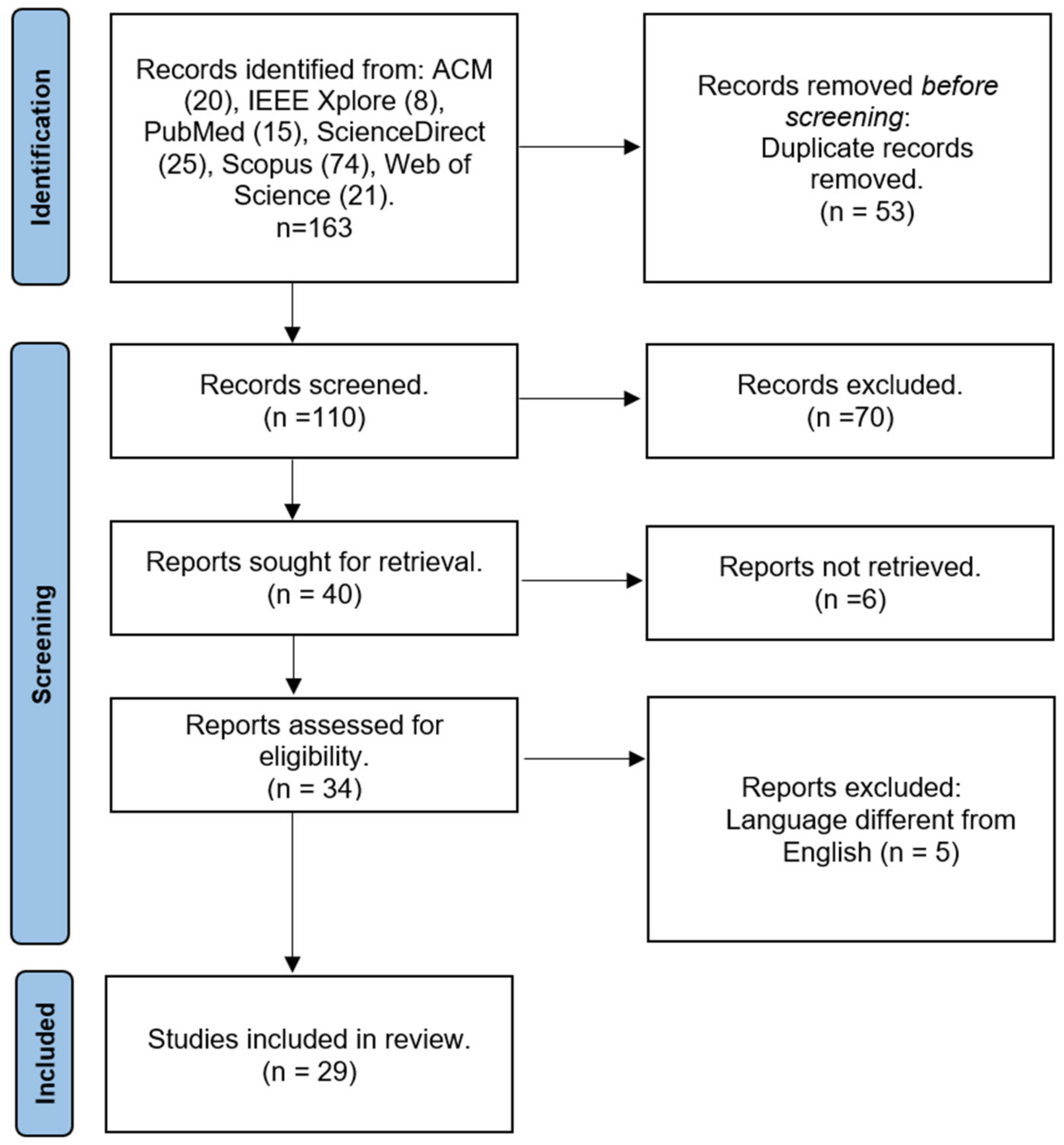
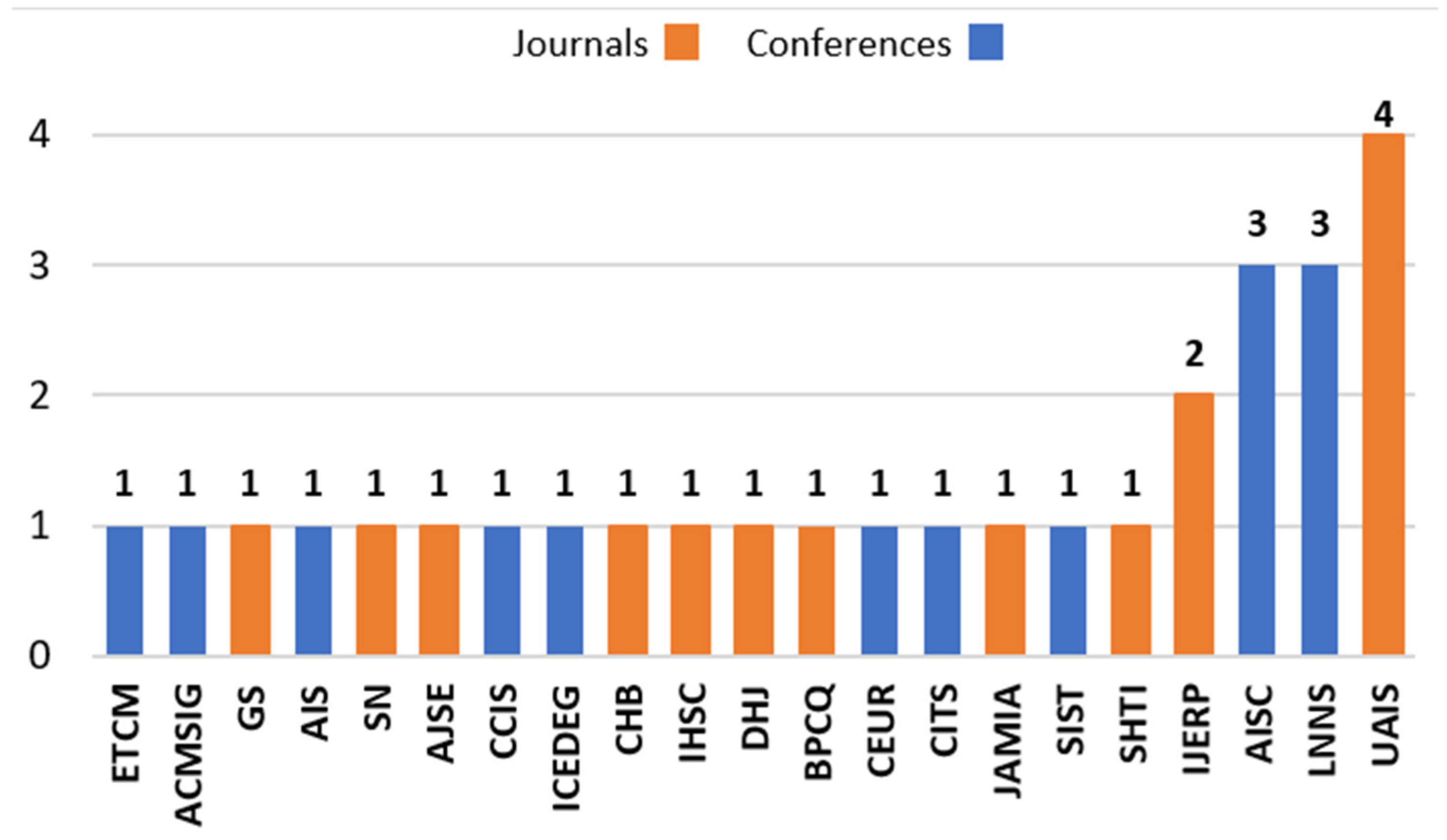
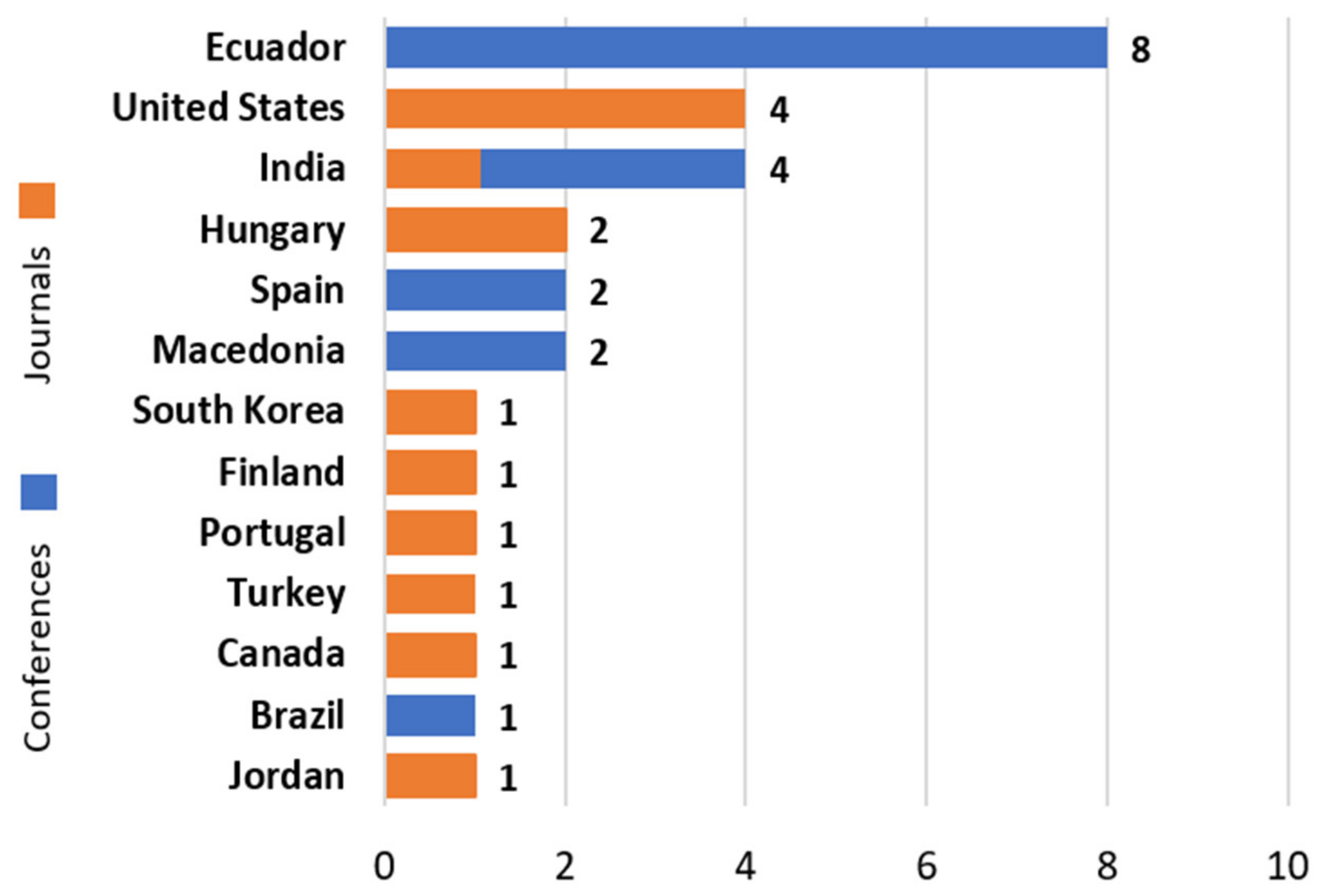
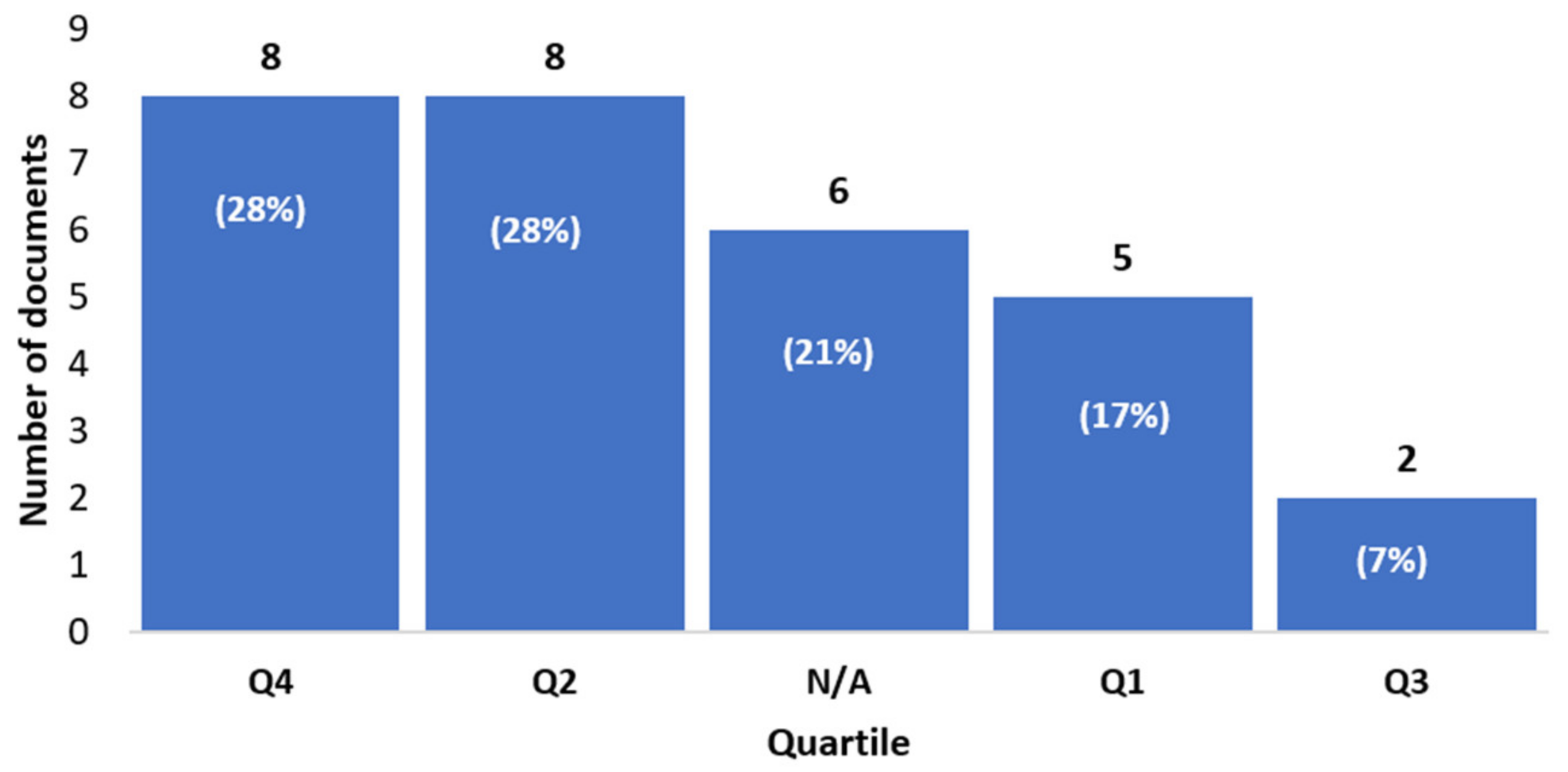
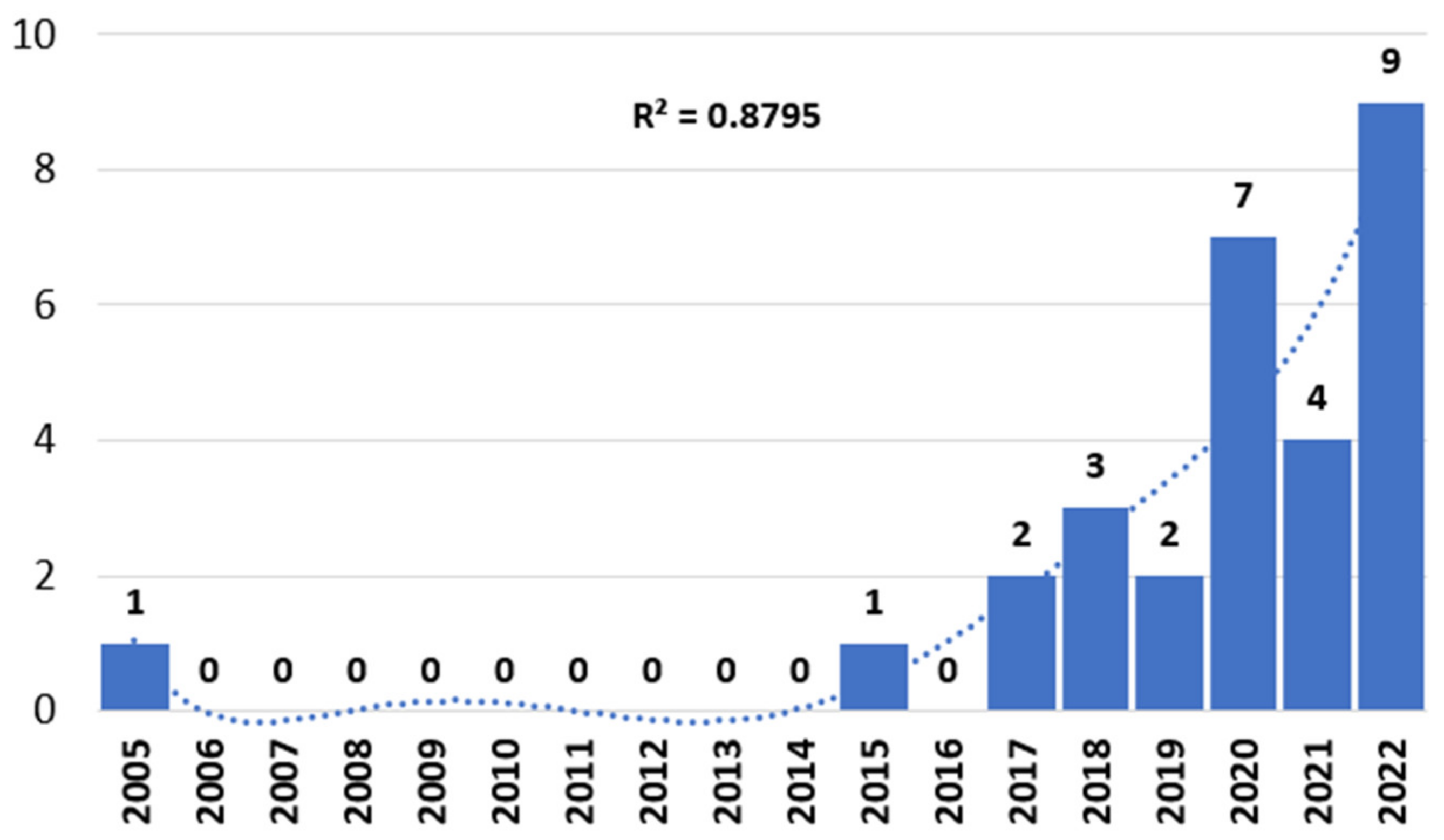
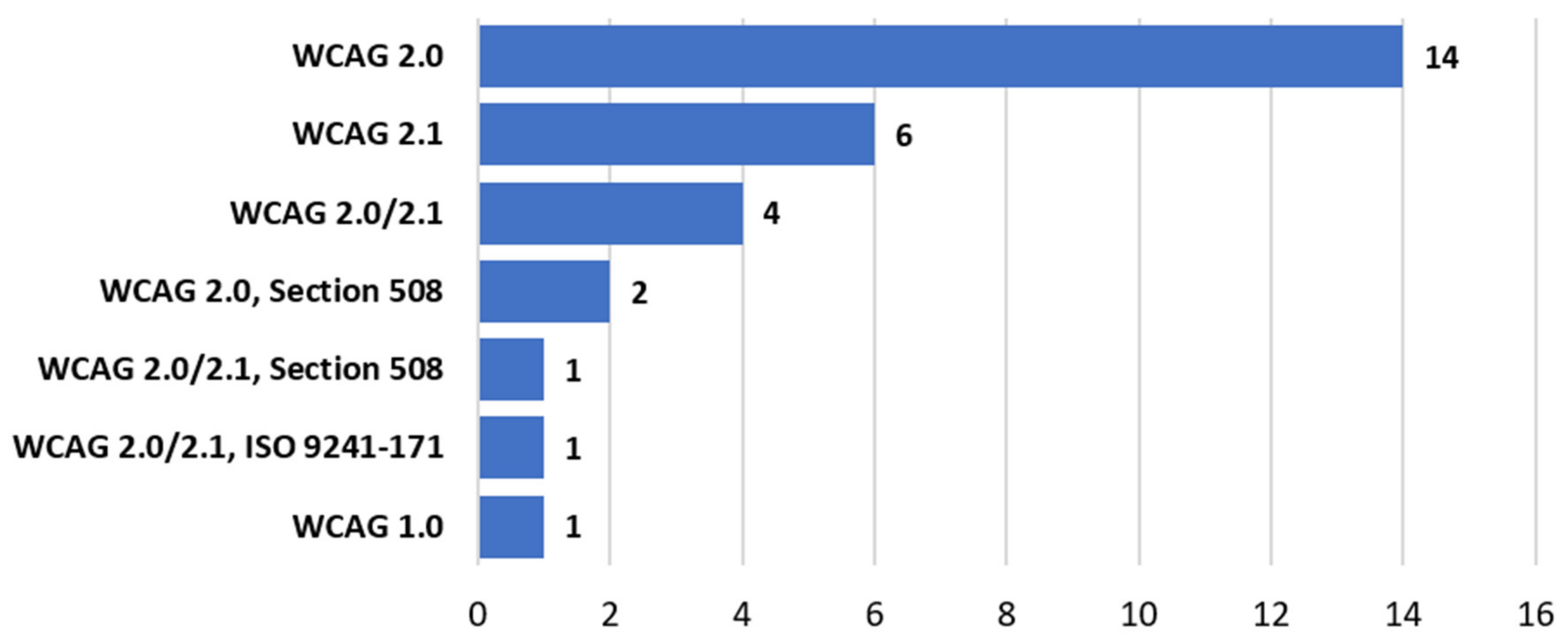
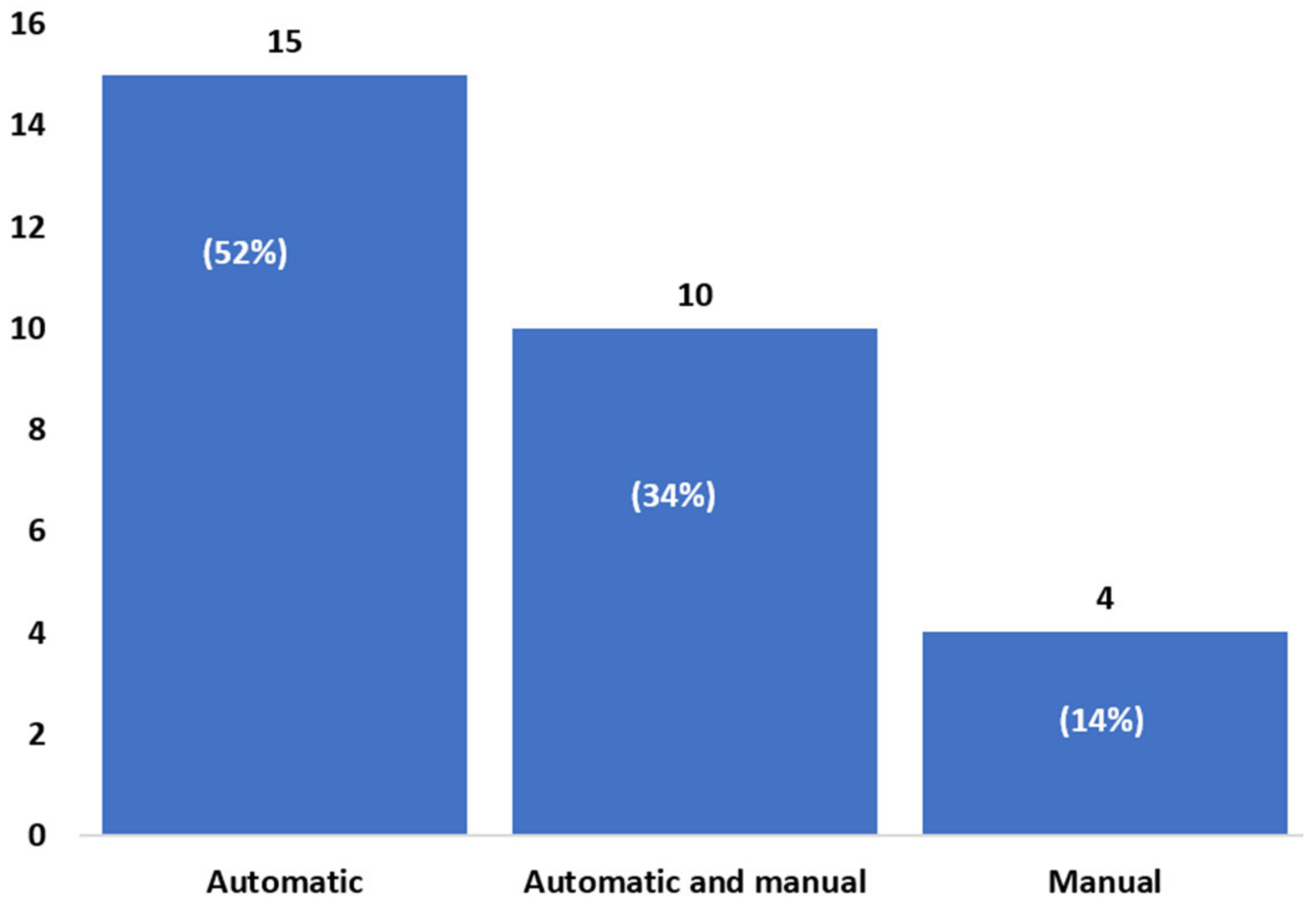
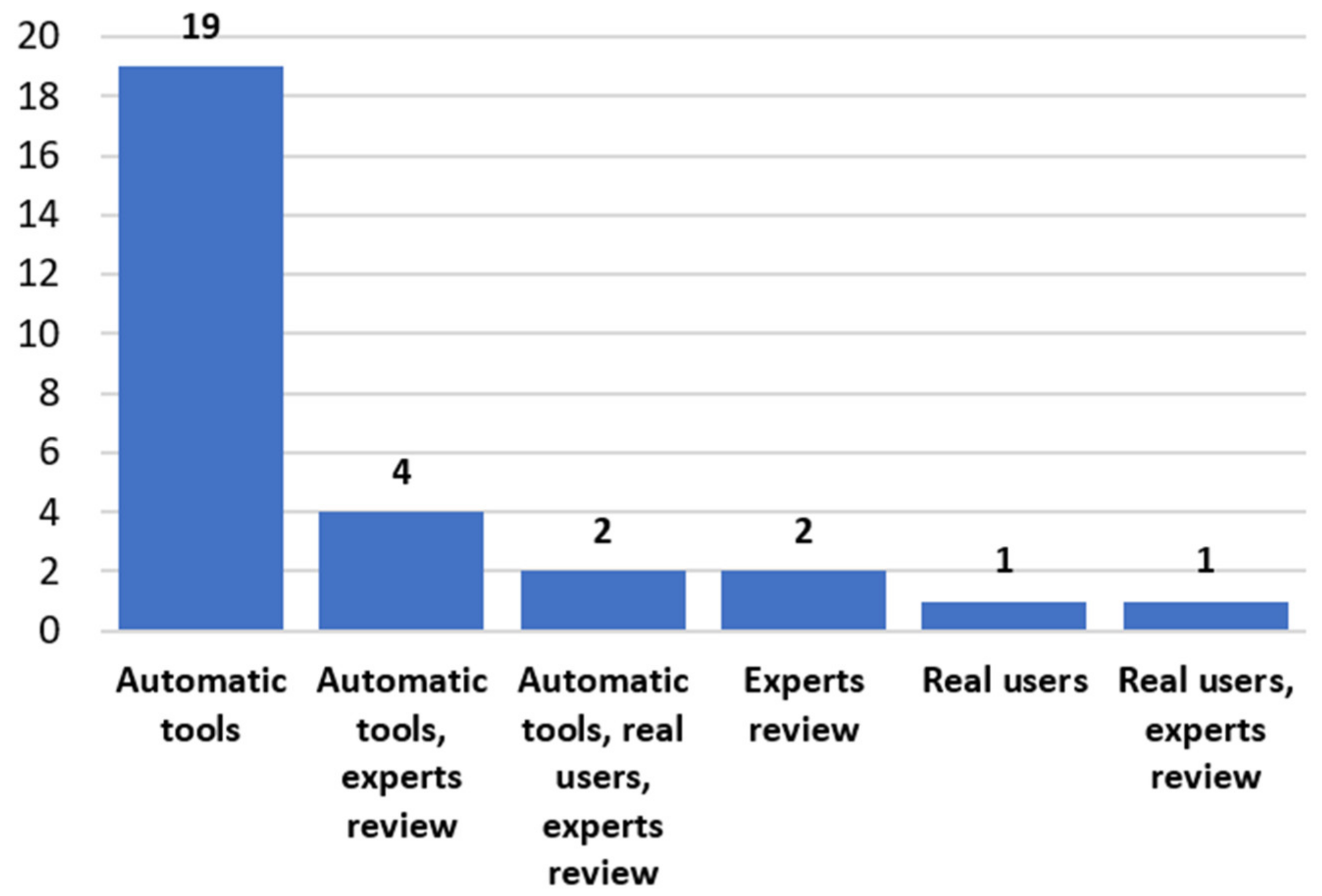
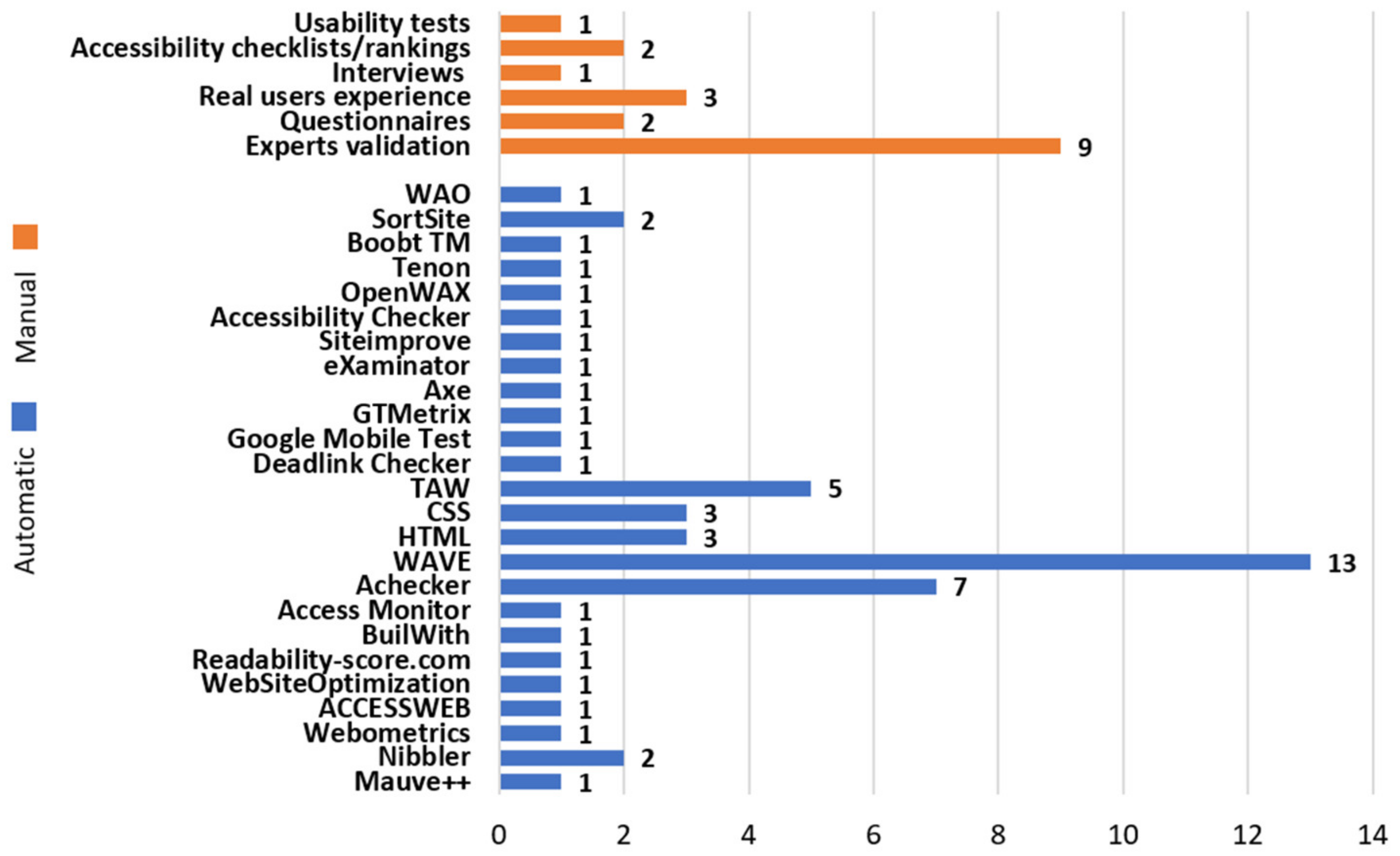
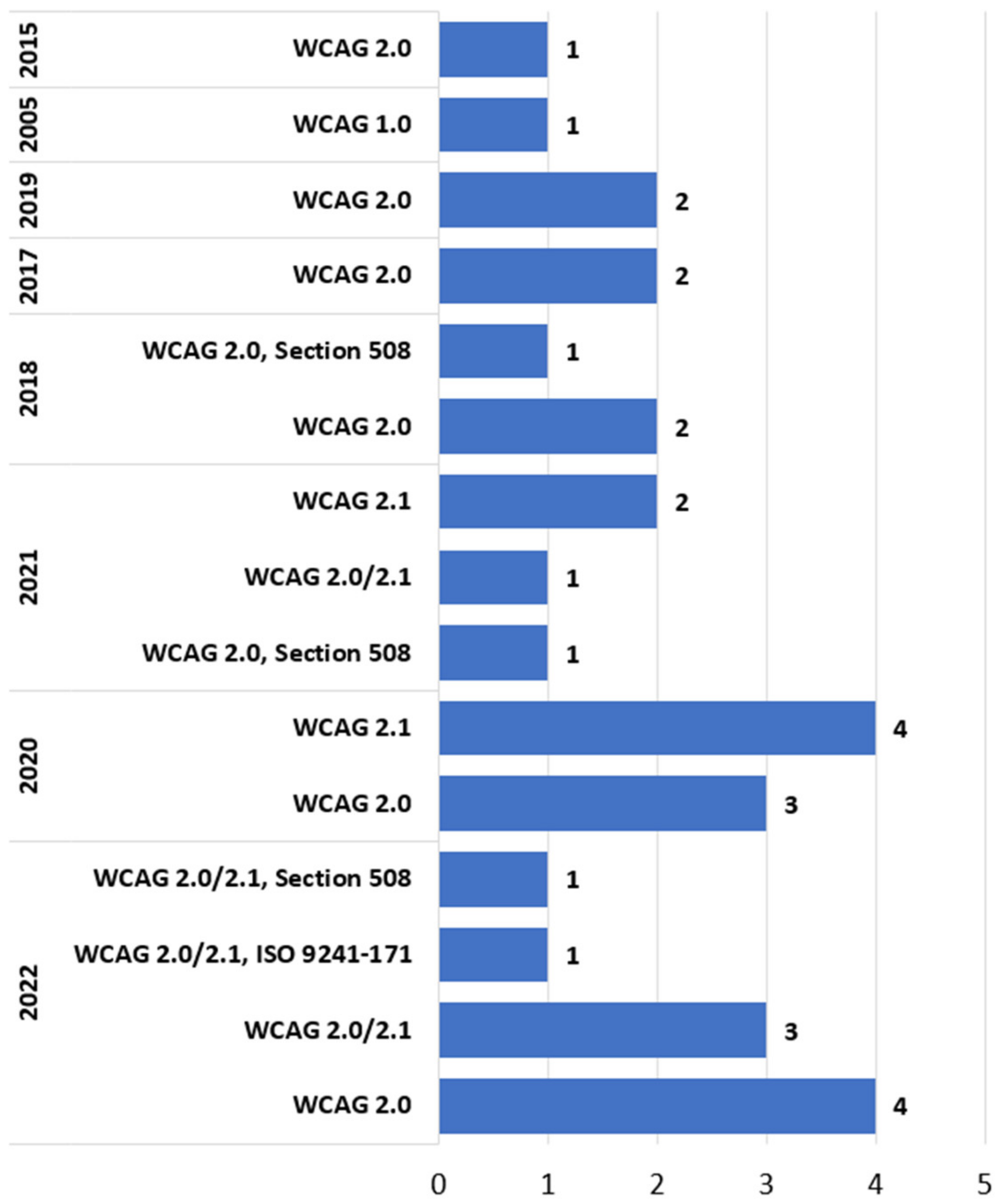

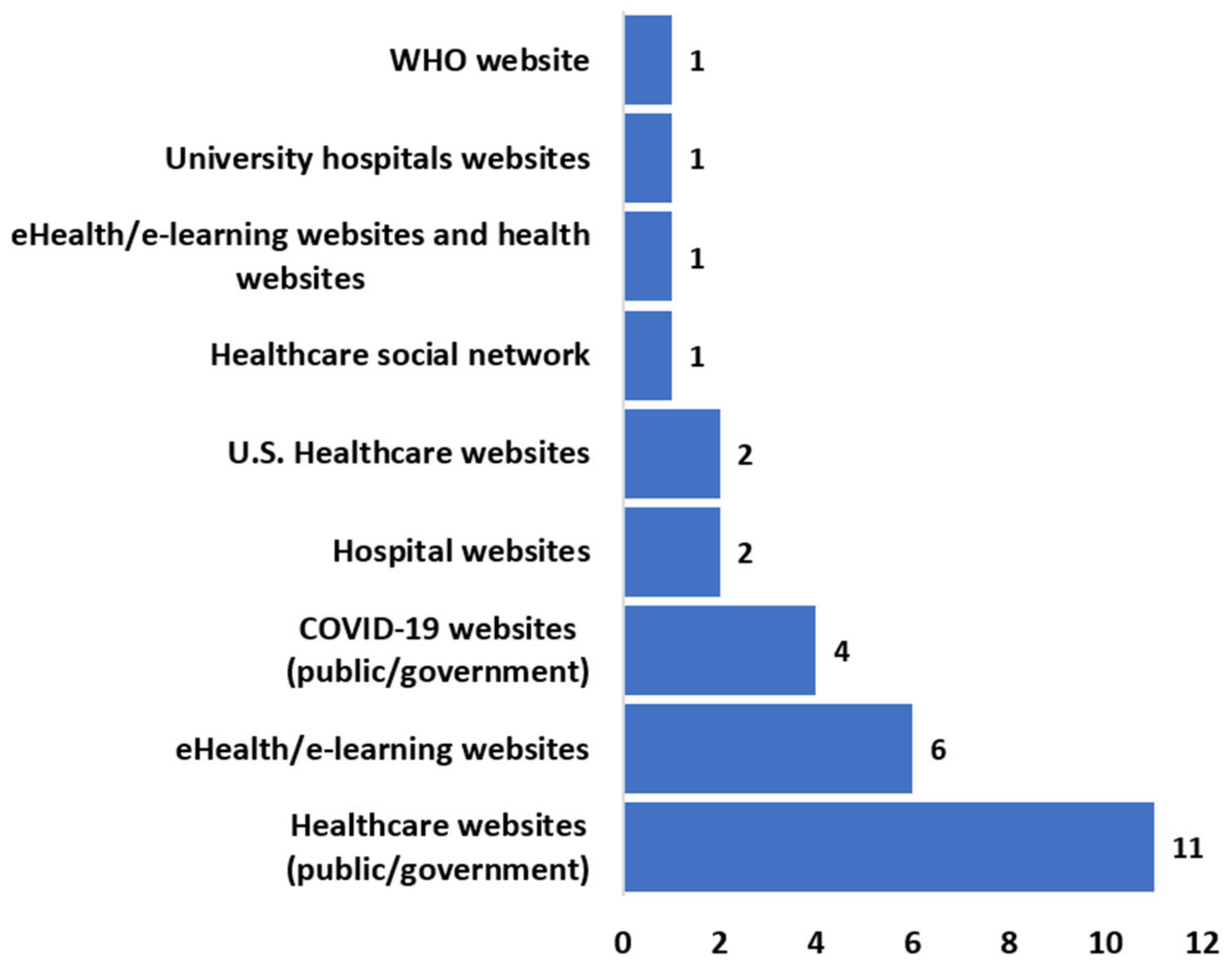
| No. | Research Question | Motivation |
|---|---|---|
| RQ1 | Which journals publish papers on the web accessibility of healthcare? | To evaluate the journals of the published papers. |
| RQ2 | What is the journal ranking for the included papers? | To examine the relevance and quality of the selected papers. |
| RQ3 | What is the frequency of publication of web accessibility studies in healthcare over time? | To understand the development of the publications over time. |
| RQ4 | What are the standards and disability guidelines used in the included papers? | To establish the standards and disability guidelines used in the included papers. |
| RQ5 | What empirical methods are used to evaluate the accessibility of health-related platforms? | To analyze the types of empirical validation methods used for this evaluation. |
| RQ6 | What type of online tools or services, real users, and experts have helped to evaluate website accessibility? | To recognize the accessibility assessment tools used in accessibility assessment. |
| RQ7 | What are the disabilities analyzed in the accessibility evaluations of healthcare platforms? | To determine the disabilities analyzed in accessibility studies about health websites. |
| RQ8 | What are the WCAG and conformance levels that have been used in the evaluation of healthcare platforms? | To identify the WCAG used in the evaluation of health platforms. |
| RQ9 | Does the document describe the errors or faults detected when evaluating the accessibility of a website? | To establish whether the article identifies the errors related to accessibility. |
| RQ10 | What are the results obtained from evaluating the accessibility of health-related platforms? | To understand the results obtained from the accessibility evaluation. |
| Database | Search String | Number of Studies |
|---|---|---|
| ACM Digital Library | [[All: web] OR [All: platforms]] AND [All: wcag] AND [All: health] | 20 |
| IEEE Xplore | (web OR platforms) AND wcag AND health | 8 |
| PubMed | (web OR platforms) AND wcag AND health | 15 |
| ScienceDirect | (web OR platforms) AND wcag AND health | 25 |
| Scopus | (web OR platforms) AND wcag AND health | 74 |
| Web of Science | (web OR platforms) AND wcag AND health | 21 |
| Total | 163 |
| No. | Quality Assessment Questions | Answer |
|---|---|---|
| QA1 | Does the paper relate to accessibility in health platforms? | (+1) Yes/(+0) No |
| QA2 | Does the paper specify the WCAG standards applied to accessibility evaluations of health platforms? | (+1) Yes/(+0) No |
| QA3 | Does the paper discuss any findings on the accessibility evaluations of health platforms? | (+1) Yes/(+0) No |
| QA4 | Are limitations described in the health platforms considered for accessibility assessments? | (+1) Yes/(+0) No |
| QA5 | Is the journal or conference publisher indexed in the SJR? | (+1) if it is ranked Q1, (+0.75) if it is ranked Q2, (+0.50) if it is ranked Q3, (+0.25) if it is ranked Q4, (+0.0) if it is not ranked. |
| ID | Publication Name | Quartile | SJR Factor | QA1 | QA2 | QA3 | QA4 | QA5 | Score | Normalization |
|---|---|---|---|---|---|---|---|---|---|---|
| JiA22 | Investigation of COVID-19 Vaccine Information Websites across Europe and Asia Using Automated Accessibility Protocols | Q2 | 0.83 | 1 | 1 | 1 | 1 | 0.75 | 4.75 | 0.8 |
| TeN22 | Accessibility of COVID-19 Websites of Asian Countries: An Evaluation Using Automated Tools | Q2 | 0.6 | 1 | 1 | 1 | 1 | 0.75 | 4.75 | 0.8 |
| NaA22 | Evaluating the accessibility of public health websites: An exploratory cross-country study | Q2 | 0.75 | 1 | 1 | 1 | 1 | 0.75 | 4.75 | 0.8 |
| NaB22 | Implementation of e-learning Platform for Increasing Digital Health Literacy as a Condition for Integration of e-health Services with PHR | N/A | 0 | 1 | 1 | 1 | 1 | 0.00 | 4.00 | 0.0 |
| AnB22 | Implementation of Innovative e-Health Services and Digital Healthcare Ecosystem Cross4all Project Summary | N/A | 0.2 | 1 | 1 | 1 | 1 | 0.00 | 4.00 | 0.0 |
| SeM22 | Accessibility evaluation of university hospital websites in Turkey | Q2 | 0.75 | 1 | 1 | 1 | 1 | 0.75 | 4.75 | 0.8 |
| KuS22a | Accessibility and Performance Evaluation of Healthcare and E-Learning Sites in India: A Comparative Study Using TAW and GTMetrix | Q4 | 0.17 | 1 | 1 | 1 | 1 | 0.25 | 4.25 | 0.3 |
| KuS22b | Accessibility of Healthcare Sites: Evaluation by Automated Tools | Q4 | 0.15 | 1 | 1 | 1 | 1 | 0.25 | 4.25 | 0.3 |
| GlA21 | Improvement of Accessibility in Medical and Healthcare Websites | Q4 | 0.15 | 1 | 1 | 1 | 1 | 0.25 | 4.25 | 0.3 |
| PaA21 | Challenges of Web Accessibility in a Health Application to Predict Neonatal Mortality—The Score Bebe ® | Q4 | 0.15 | 1 | 1 | 1 | 1 | 0.25 | 4.25 | 0.3 |
| ElF20 | We are exploring who communication during the COVID-19 pandemic through the Who website based on W3C guidelines: Accessible for all? | Q2 | 0.83 | 1 | 1 | 1 | 1 | 0.75 | 4.75 | 0.8 |
| MuA20 | Effectiveness of web accessibility policy implementation in online healthcare information | Q3 | 0.29 | 1 | 1 | 1 | 1 | 0.50 | 4.5 | 0.5 |
| PaA20a | Web Accessibility Analysis of a Tele-Rehabilitation Platform: The Physiotherapist Perspective | Q4 | 0 | 1 | 1 | 1 | 1 | 0.25 | 4.25 | 0.3 |
| PaA20b | Designing an Accessible Website for Palliative Care Services | Q4 | 0.19 | 1 | 1 | 1 | 1 | 0.25 | 4.25 | 0.3 |
| PaA20c | Challenges and improvements in website accessibility for health services | Q4 | 0 | 1 | 1 | 1 | 1 | 0.25 | 4.25 | 0.3 |
| PaA20d | Improving web accessibility: Evaluation and analysis of a telerehabilitation platform for hip arthroplasty patients | Q4 | 0 | 1 | 1 | 1 | 1 | 0.25 | 4.25 | 0.3 |
| CeS19 | Accessibility Testing of European Health-Related Websites | Q1 | 0.48 | 1 | 1 | 1 | 1 | 1.00 | 5 | 1.0 |
| LuC19 | Web accessibility of Internet appointment scheduling in primary care | Q3 | 0.47 | 1 | 1 | 1 | 1 | 0.50 | 4.5 | 0.5 |
| PaA18a | Towards Web Accessibility in Telerehabilitation Platforms | N/A | 0 | 1 | 1 | 1 | 1 | 0.00 | 4 | 0.0 |
| PaA18b | Framework for Accessibility Evaluation of Hospital Websites | N/A | 0 | 1 | 1 | 1 | 1 | 0.00 | 4 | 0.0 |
| JoM17 | A full-scope web accessibility evaluation procedure proposal based on Iberian eHealth accessibility compliance | Q1 | 2.46 | 1 | 1 | 1 | 1 | 1.00 | 5 | 1.0 |
| ArK17 | Evaluating the accessibility, usability, and security of Hospitals websites: An exploratory study | N/A | 0 | 1 | 1 | 1 | 1 | 0.00 | 4 | 0.0 |
| EdL15 | My health: An online healthcare social network inclusive for elderly people | N/A | 0 | 1 | 1 | 1 | 1 | 0.00 | 4 | 0.0 |
| LaO05 | Accessibility compliance rates of consumer-oriented Canadian health care Web sites | Q1 | 0.74 | 1 | 1 | 1 | 1 | 1.00 | 5 | 1.0 |
| GrB22 | COVID-19 vaccine website accessibility dashboard | Q1 | 1.64 | 1 | 1 | 1 | 1 | 1.00 | 5 | 1.0 |
| SaA21 | Accessibility evaluation of COVID-19 vaccine registration websites across the United States | Q1 | 2.44 | 1 | 1 | 1 | 1 | 1.00 | 5 | 1.0 |
| NoY18 | Website Accessibility: U.S. Veterans Affairs Medical Centers as a Case Study | Q2 | 0.48 | 1 | 1 | 1 | 1 | 0.75 | 4.75 | 0.8 |
| NoY21 | The accessibility of state occupational safety and health consultation websites | Q2 | 0.75 | 1 | 1 | 1 | 1 | 0.75 | 4.75 | 0.8 |
| No. | Paper ID | Title | Reference | Year |
|---|---|---|---|---|
| 1 | JiA22 | Investigation of COVID-19 Vaccine Information Websites across Europe and Asia using Automated Accessibility | Ara, J. [30] | 2022 |
| 2 | TeN22 | Accessibility of COVID-19 Websites of Asian Countries: An Evaluation Using Automated Tools | Niom, T. [31] | 2022 |
| 3 | NaA22 | Evaluating the accessibility of public health websites: An exploratory cross-country study | Alajarmeh, N. [32] | 2022 |
| 4 | NaB22 | Implementation of e-learning Platform for Increasing Digital Health Literacy as a Condition for Integration of e-health Services with PHR | Blazheska-Tabakovska, N. [33] | 2022 |
| 5 | AnB22 | Implementation of Innovative e-Health Services and Digital Healthcare Ecosystem Cross4all Project Summary | Bocevska, A. [34] | 2022 |
| 6 | SeM22 | Accessibility evaluation of university hospital websites in Turkey | Macakoğlu, Ş. [35] | 2022 |
| 7 | KuS22a | Accessibility and Performance Evaluation of Healthcare and E-Learning Sites in India: A Comparative Study Using TAW and GTMetrix | Sarita, K. [36] | 2022 |
| 8 | KuS22b | Accessibility of Healthcare Sites: Evaluation by Automated Tools | Sarita, K. [15] | 2022 |
| 9 | GrB22 | COVID-19 vaccine website accessibility dashboard | Jo, G. [37] | 2022 |
| 10 | GlA21 | Improvement of Accessibility in Medical and Healthcare Websites | Acosta-Vargas, G. [38] | 2021 |
| 11 | PaA21 | Challenges of Web Accessibility in a Health Application to Predict Neonatal Mortality: The Score Bebe ® | Acosta-Vargas, P. [39] | 2021 |
| 12 | SaA21 | Accessibility evaluation of COVID-19 vaccine registration websites across the United States | Alismail, S. [40] | 2021 |
| 13 | NoY21 | The accessibility of state occupational safety and health consultation websites | Youngblood, N. [41] | 2021 |
| 14 | ElF20 | I am exploring WHO communication during the COVID-19 pandemic through the who website based on W3C guidelines: Accessible for all? | Fernández-Díaz, E. [42] | 2020 |
| 15 | MuA20 | Effectiveness of web accessibility policy implementation in online healthcare information | Arief, M. [43] | 2020 |
| 16 | YoJ20 | Web accessibility of healthcare Web sites of Korean government and public agencies: a user test for persons with visual impairment | Yi, Y.J. [44] | 2020 |
| 17 | PaA20a | Web Accessibility Analysis of a Tele-Rehabilitation Platform: The Physiotherapist Perspective | Acosta-Vargas, P. [45] | 2020 |
| 18 | PaA20b | Designing an Accessible Website for Palliative Care Services | Acosta-Vargas, P. [46] | 2020 |
| 19 | PaA20c | Challenges and improvements in website accessibility for health services | Acosta-Vargas, P. [47] | 2020 |
| 20 | PaA20d | Improving web accessibility: Evaluation and analysis of a telerehabilitation platform for hip arthroplasty patients | Acosta-Vargas, P. [48] | 2020 |
| 21 | CeS19 | Accessibility Testing of European Health-Related Websites | Sik-Lanyi, C. [49] | 2019 |
| 22 | LuC19 | Web accessibility of Internet appointment scheduling in primary care | Casasola Balsells, L.A. [50] | 2019 |
| 23 | PaA18a | Towards Web Accessibility in Telerehabilitation Platforms | Acosta-Vargas, P. [51] | 2018 |
| 24 | PaA18b | Framework for Accessibility Evaluation of Hospital Websites | Acosta-Vargas, P. [52] | 2018 |
| 25 | NoY18 | Website Accessibility: U.S. Veterans Affairs Medical Centers as a Case Study | Youngblood, N. [53] | 2018 |
| 26 | JoM17 | A full-scope web accessibility evaluation procedure proposal based on Iberian eHealth accessibility compliance | Martins, J. [54] | 2017 |
| 27 | ArK17 | Evaluating the accessibility, usability, and security of Hospitals websites: An exploratory study | Kaur, A. [55] | 2017 |
| 28 | EdL15 | My health: An online healthcare social network inclusive for elderly people | Medina, E.L. [56] | 2015 |
| 29 | LaO05 | Accessibility compliance rates of consumer-oriented Canadian healthcare Web sites | O’Grady, L. [57] | 2005 |
| Sources | No. Analyzed Websites |
|---|---|
| Healthcare social networks | 1 |
| Hospital websites | 401 |
| U.S. Healthcare websites | 166 |
| University hospitals’ websites | 58 |
| WHO website | 6 |
| COVID-19 websites (public/government) | 176 |
| Healthcare websites (public/government) | 270 |
| eHealth/e-learning websites | 30 |
| eHealth/e-learning websites, healthcare websites | 10 |
| General total | 1118 |
Disclaimer/Publisher’s Note: The statements, opinions and data contained in all publications are solely those of the individual author(s) and contributor(s) and not of MDPI and/or the editor(s). MDPI and/or the editor(s) disclaim responsibility for any injury to people or property resulting from any ideas, methods, instructions or products referred to in the content. |
© 2023 by the authors. Licensee MDPI, Basel, Switzerland. This article is an open access article distributed under the terms and conditions of the Creative Commons Attribution (CC BY) license (https://creativecommons.org/licenses/by/4.0/).
Share and Cite
Ramírez-Saltos, D.; Acosta-Vargas, P.; Acosta-Vargas, G.; Santórum, M.; Carrion-Toro, M.; Ayala-Chauvin, M.; Ortiz-Prado, E.; Maldonado-Garcés, V.; González-Rodríguez, M. Enhancing Sustainability through Accessible Health Platforms: A Scoping Review. Sustainability 2023, 15, 15916. https://doi.org/10.3390/su152215916
Ramírez-Saltos D, Acosta-Vargas P, Acosta-Vargas G, Santórum M, Carrion-Toro M, Ayala-Chauvin M, Ortiz-Prado E, Maldonado-Garcés V, González-Rodríguez M. Enhancing Sustainability through Accessible Health Platforms: A Scoping Review. Sustainability. 2023; 15(22):15916. https://doi.org/10.3390/su152215916
Chicago/Turabian StyleRamírez-Saltos, Domenica, Patricia Acosta-Vargas, Gloria Acosta-Vargas, Marco Santórum, Mayra Carrion-Toro, Manuel Ayala-Chauvin, Esteban Ortiz-Prado, Verónica Maldonado-Garcés, and Mario González-Rodríguez. 2023. "Enhancing Sustainability through Accessible Health Platforms: A Scoping Review" Sustainability 15, no. 22: 15916. https://doi.org/10.3390/su152215916
APA StyleRamírez-Saltos, D., Acosta-Vargas, P., Acosta-Vargas, G., Santórum, M., Carrion-Toro, M., Ayala-Chauvin, M., Ortiz-Prado, E., Maldonado-Garcés, V., & González-Rodríguez, M. (2023). Enhancing Sustainability through Accessible Health Platforms: A Scoping Review. Sustainability, 15(22), 15916. https://doi.org/10.3390/su152215916









